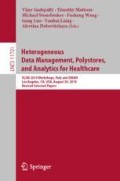Abstract
Generating differential diagnosis has been a subjective process primarily relying on a physician’s experience. However, the increased availability of electronic health records (EHRs) means that this process has the potential to benefit from machine learning-based decision support technology. No differential diagnosis models are currently available for heart disease, particularly for physicians in emergency departments (EDs). In this paper, we applied the decision tree method to automatically build a heart disease differential diagnosis model from structured and unstructured ED data. Our results show that the automatically learned model can achieve a classification accuracy of 89%. Our study demonstrates that data-driven differential diagnosis rules can be automatically learned from analyzing EHR data and that this learning can be clinically meaningful when merged with external medical knowledge.
Access this chapter
Tax calculation will be finalised at checkout
Purchases are for personal use only
References
Barnett, G.O., Cimino, J.J., Hupp, J.A., Hoffer, E.P.: DXplain: an evolving diagnostic decision-support system. JAMA 258(1), 67–74 (1987)
Beam, A.L., et al.: Clinical concept embeddings learned from massive sources of multimodal medical data. arXiv preprint arXiv:1804.01486 (2018)
Berner, E.S., Graber, M.L.: Overconfidence as a cause of diagnostic error in medicine. Am. J. Med. 121(5), S2–S23 (2008)
Bond, W.F., Schwartz, L.M., Weaver, K.R., Levick, D., Giuliano, M., Graber, M.L.: Differential diagnosis generators: an evaluation of currently available computer programs. J. Gen. Intern. Med. 27(2), 213–219 (2012)
Breiman, L.: Classification and Regression Trees. Routledge, Abingdon (2017)
Brown, T.W., McCarthy, M.L., Kelen, G.D., Levy, F.: An epidemiologic study of closed emergency department malpractice claims in a national database of physician malpractice insurers. Acad. Emerg. Med. 17(5), 553–560 (2010)
Cowie, M.R., et al.: Electronic health records to facilitate clinical research. Clin. Res. Cardiol. 106(1), 1–9 (2017)
Dehghan, A., Kovacevic, A., Karystianis, G., Keane, J.A., Nenadic, G.: Combining knowledge-and data-driven methods for de-identification of clinical narratives. J. Biomed. Inform. 58, S53–S59 (2015)
Friedman, C., Alderson, P.O., Austin, J.H., Cimino, J.J., Johnson, S.B.: A general natural-language text processor for clinical radiology. J. Am. Med. Inform. Assoc. 1(2), 161–174 (1994)
Gorry, G.A., Barnett, G.O.: Experience with a model of sequential diagnosis. Comput. Biomed. Res. 1(5), 490–507 (1968)
Agency for Healthcare Research and Quality: Clinical classifications software (CCS) for ICD-9-CM (2015)
LeCun, Y., Bengio, Y., Hinton, G.: Deep learning. Nature 521(7553), 436 (2015)
Liaw, A., Wiener, M., et al.: Classification and regression by randomforest. R News 2(3), 18–22 (2002)
Morik, K., Brockhausen, P., Joachims, T.: Combining statistical learning with a knowledge-based approach: a case study in intensive care monitoring. Technical report, SFB 475: Komplexitätsreduktion in Multivariaten ... (1999)
Myers, J.D.: The background of INTERNIST I and QMR. In: Proceedings of ACM Conference on History of Medical Informatics, pp. 195–197. ACM (1987)
Neurath, P.W., Enslein, K., Mitchell Jr., G.W.: Design of a computer system to assist in differential preoperative diagnosis for pelvic surgery. N. Engl. J. Med. 280(14), 745–749 (1969)
World Health Organization: Diagnostic errors: technical series on safer primary care (2016)
Pineda, A.L., Ye, Y., Visweswaran, S., Cooper, G.F., Wagner, M.M., Tsui, F.R.: Comparison of machine learning classifiers for influenza detection from emergency department free-text reports. J. Biomed. Inform. 58, 60–69 (2015)
Ramnarayan, P., Tomlinson, A., Rao, A., Coren, M., Winrow, A., Britto, J.: ISABEL: a web-based differential diagnostic aid for paediatrics: results from an initial performance evaluation. Arch. Dis. Child. 88(5), 408–413 (2003)
Shortliffe, E.H., Buchanan, B.G.: Rule-Based Expert Systems: The MYCIN Experiments of the Stanford Heuristic Programming Project. Addison-Wesley Publishing Company, Boston (1985)
Sox, H.C., Blatt, M.A., Higgins, M.C., Marton, K.I.: Medical Decision Making. ACP Press, Sydney (2007)
Steinwart, I., Christmann, A.: Support Vector Machines. Information Science and Statistics. Springer, New York (2008). https://doi.org/10.1007/978-0-387-77242-4
Sun, J., et al.: Combining knowledge and data driven insights for identifying risk factors using electronic health records. In: AMIA Annual Symposium Proceedings, vol. 2012, p. 901. American Medical Informatics Association (2012)
Warner, H.R., et al.: Iliad as an expert consultant to teach differential diagnosis. In: Proceedings of the Annual Symposium on Computer Application in Medical Care, p. 371. American Medical Informatics Association (1988)
Acknowledgement
We thank Dr. Fuchiang Tsui at the Children’s Hospital of Philadelphia for helpful discussions.
Author information
Authors and Affiliations
Corresponding author
Editor information
Editors and Affiliations
Rights and permissions
Copyright information
© 2019 Springer Nature Switzerland AG
About this paper
Cite this paper
Xue, D., Frisch, A., He, D. (2019). Differential Diagnosis of Heart Disease in Emergency Departments Using Decision Tree and Medical Knowledge. In: Gadepally, V., et al. Heterogeneous Data Management, Polystores, and Analytics for Healthcare. DMAH Poly 2019 2019. Lecture Notes in Computer Science(), vol 11721. Springer, Cham. https://doi.org/10.1007/978-3-030-33752-0_16
Download citation
DOI: https://doi.org/10.1007/978-3-030-33752-0_16
Published:
Publisher Name: Springer, Cham
Print ISBN: 978-3-030-33751-3
Online ISBN: 978-3-030-33752-0
eBook Packages: Computer ScienceComputer Science (R0)

